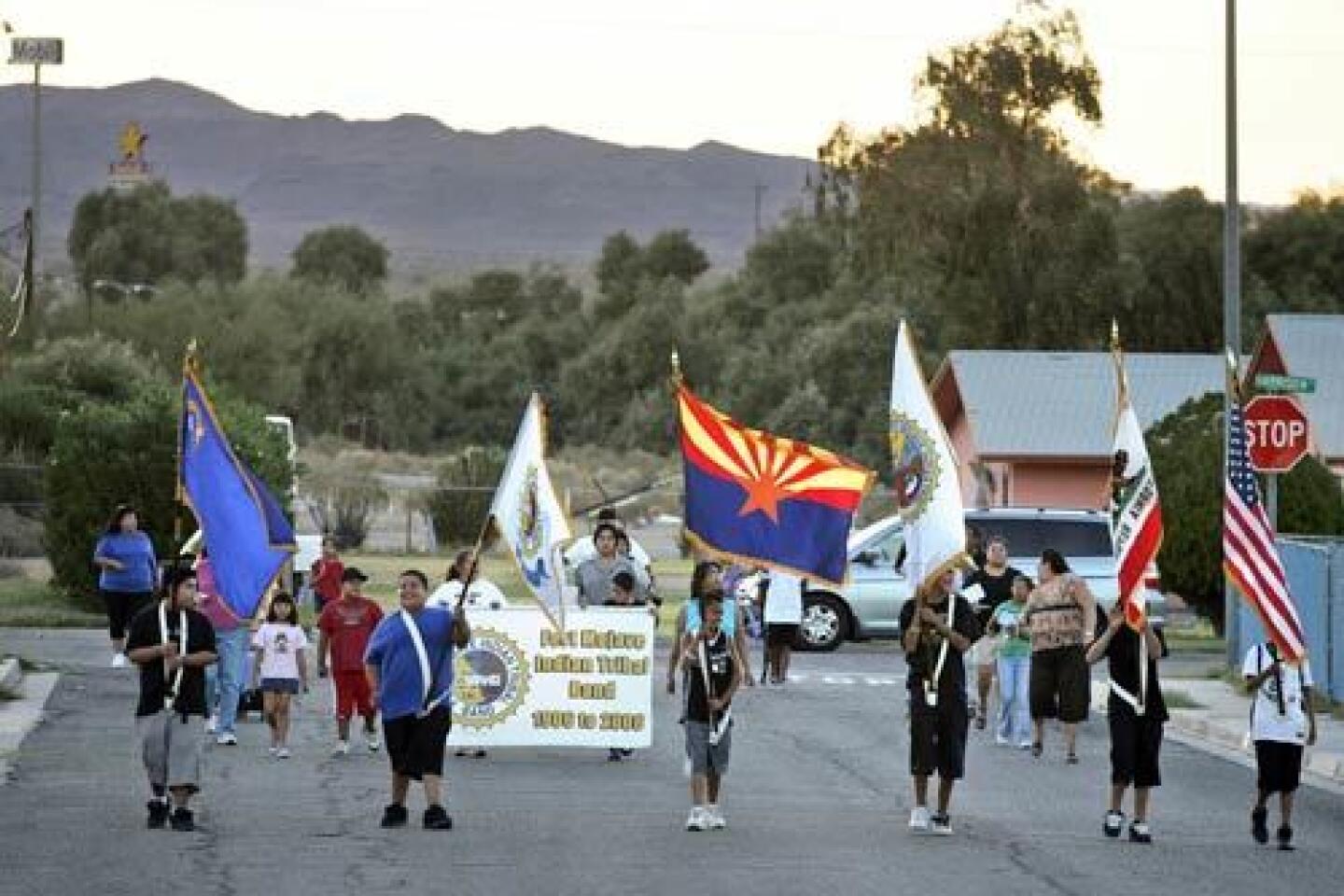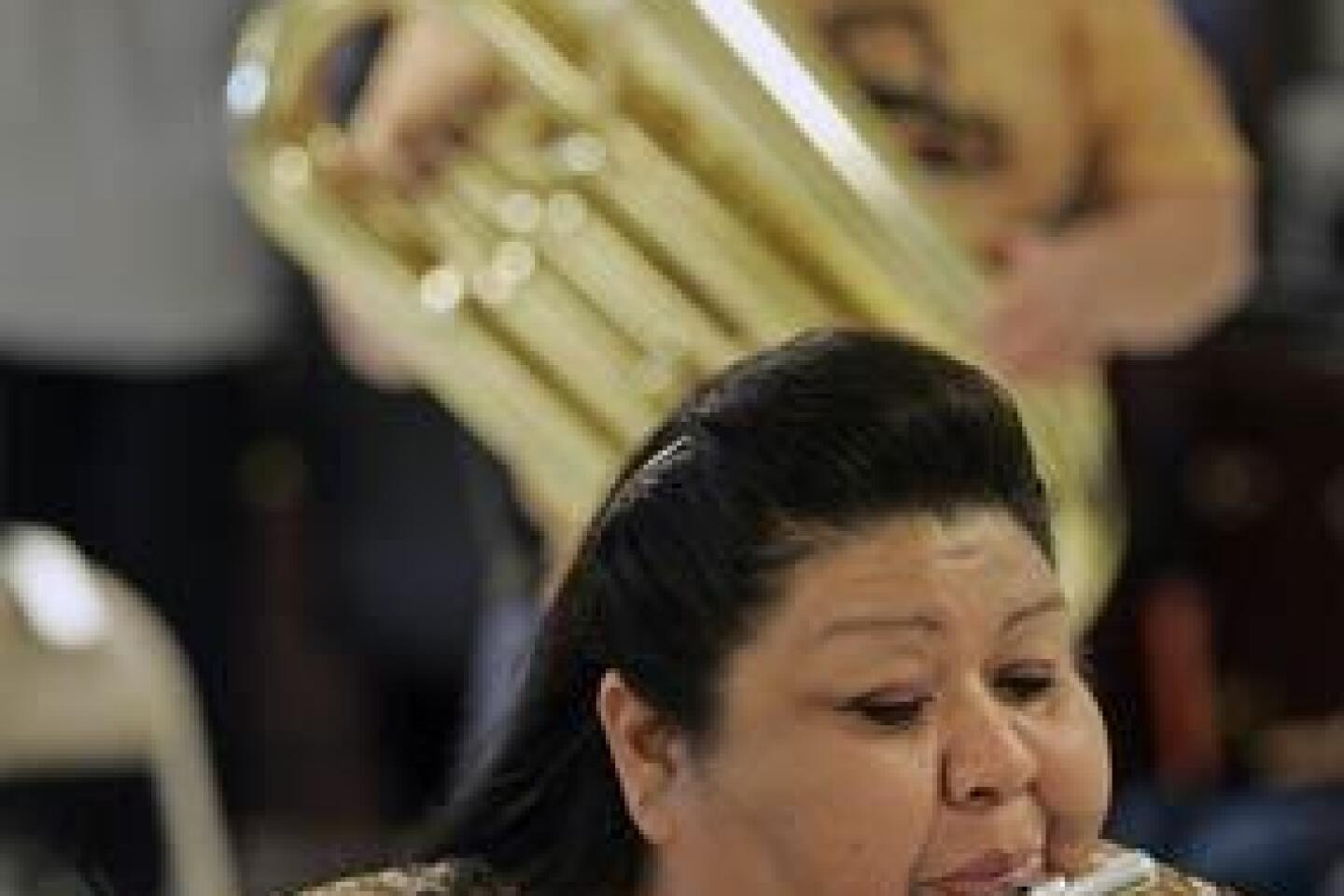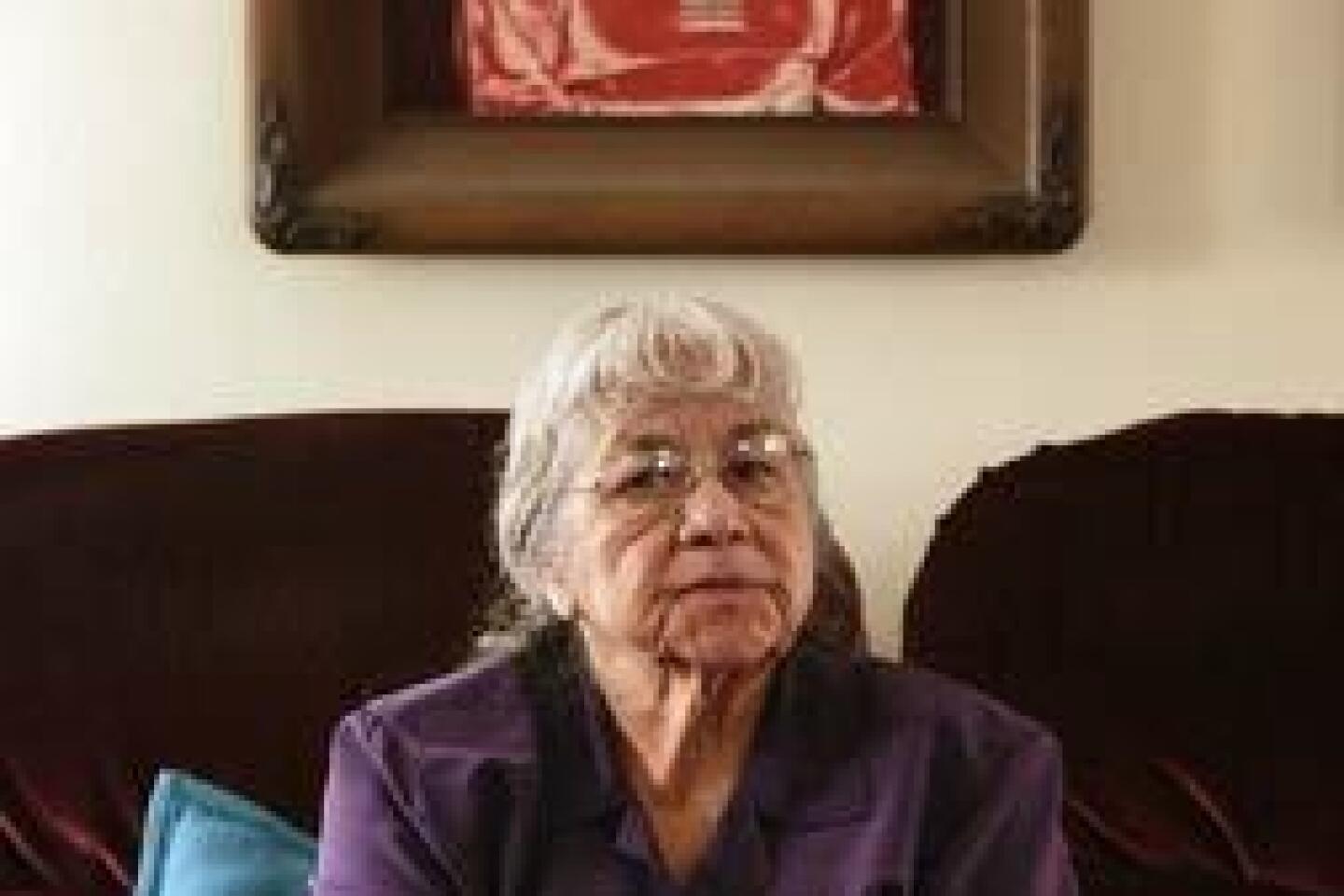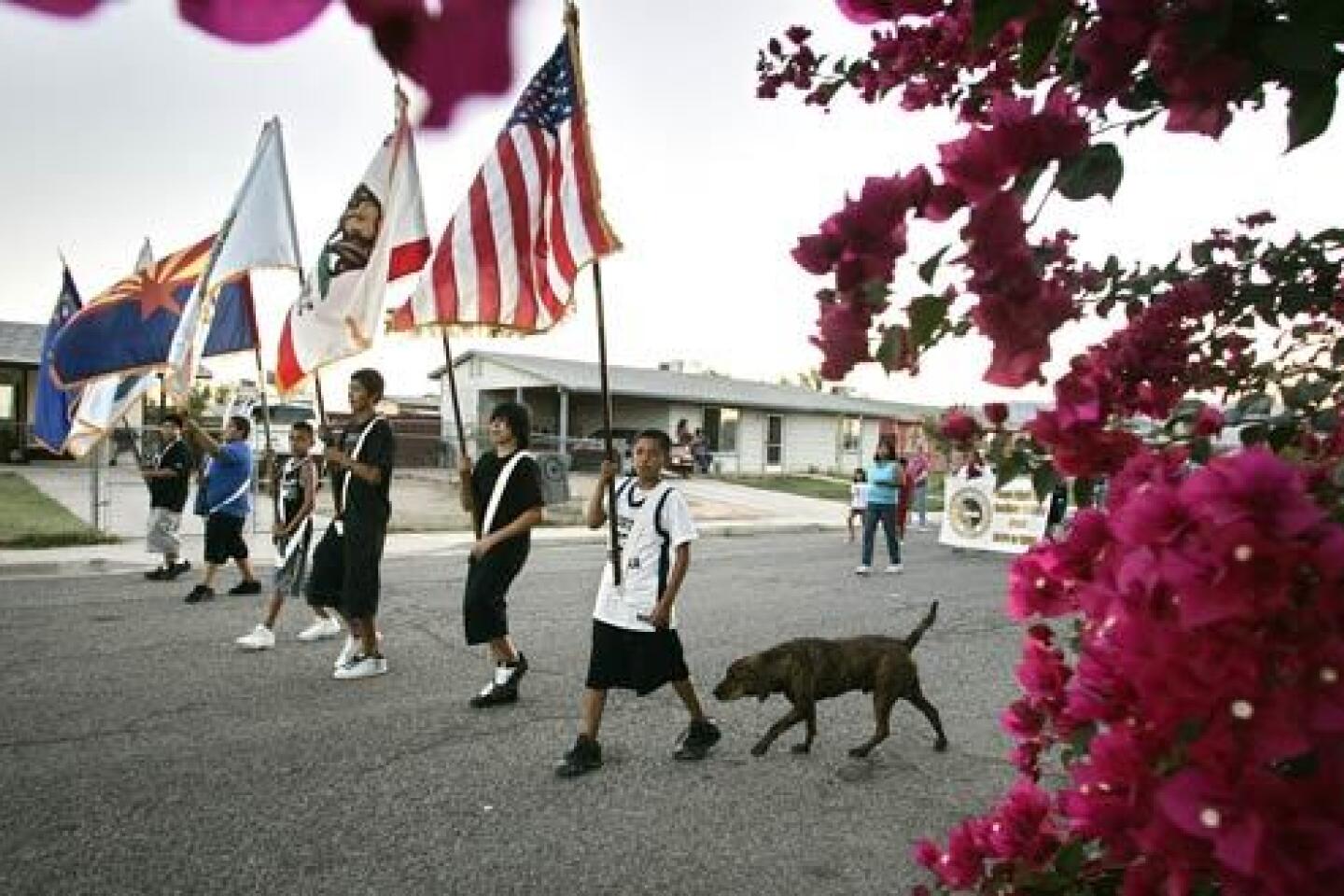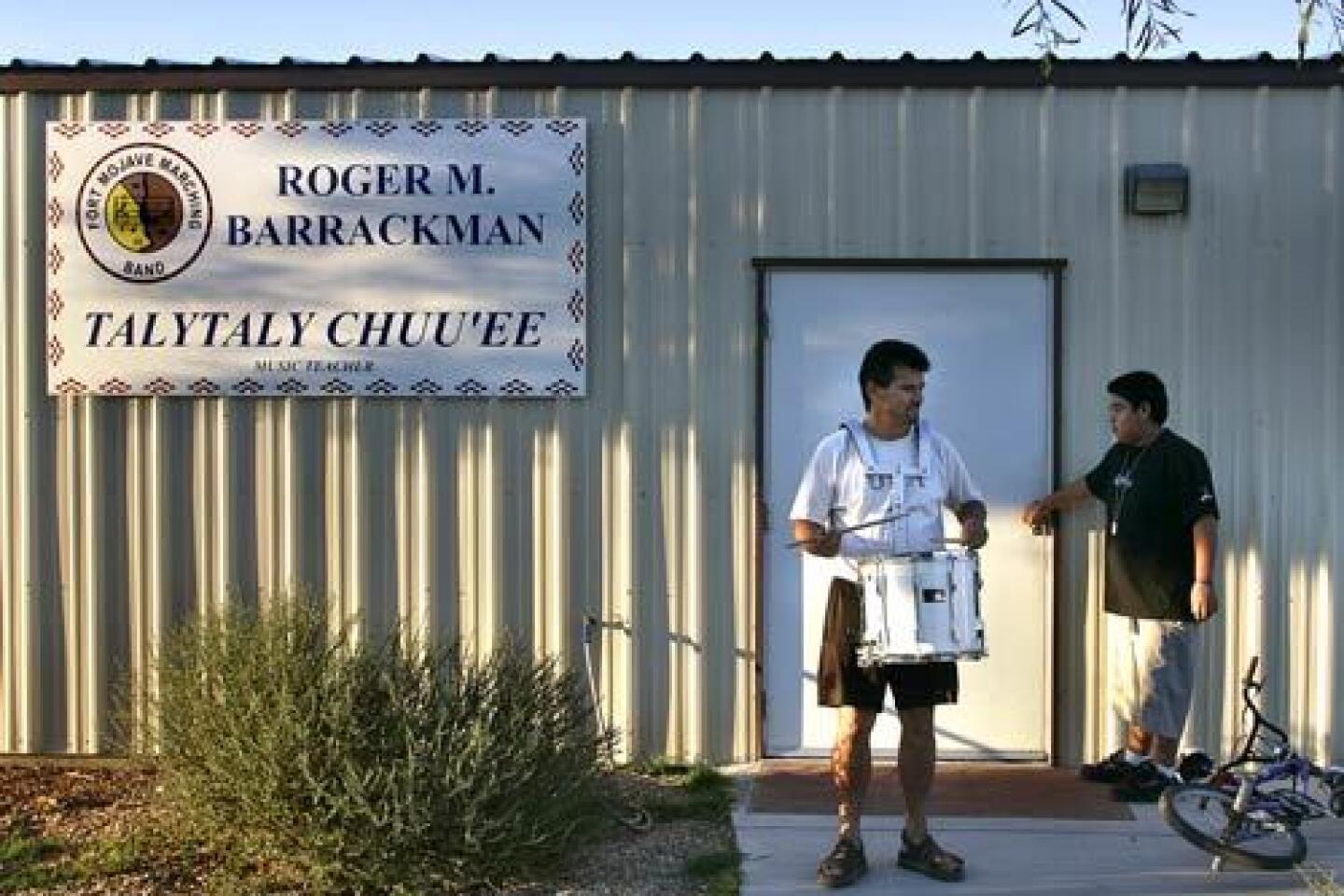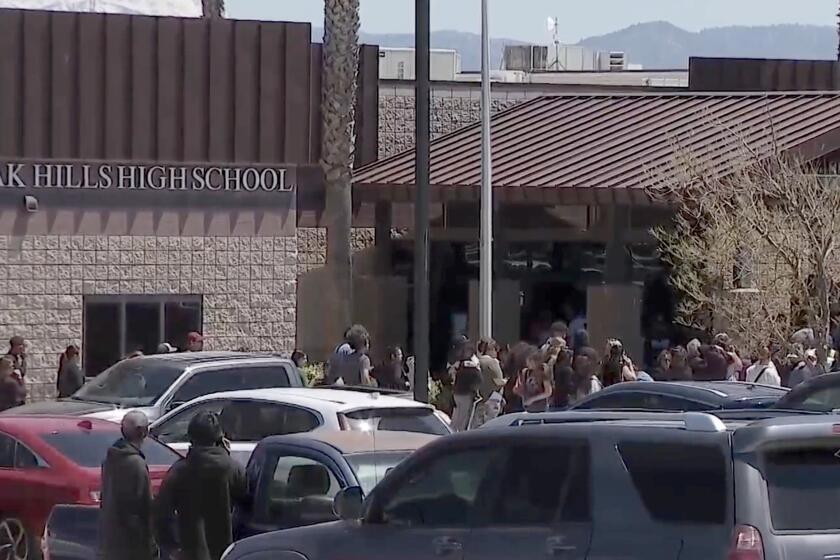A Sousa band of Indians
Needles, Calif. — AS the desert sun slides behind the mountains and the temperature dips, members of the Fort Mojave Indian Tribal Band assemble in a parking lot to rehearse. Mothers with clarinets to their lips. Young men lugging drums. Children carrying flags and streamers. A 76-year-old trumpeter in a wheelchair.
A pair of stray dogs take seats in the street, ready for the evening’s parade.
“Quickly, we’re losing daylight!” someone shouts. Soon they are parading through the bleak reservation village outside Needles to the cadence of American marching music — an improbable scene that has been a tradition here on the California-Arizona border for 100 years.
A century ago, dozens of Indian tribes nationwide had bands that played the music of John Philip Sousa and other patriotic anthems. The bands were an outgrowth of government-run boarding schools that sought, brutally at times, to erase Indian cultures, religions and languages in the name of assimilation. Only a few bands survive. The Fort Mojave tribe’s is thought to be the oldest.
Through the decades, the band has weathered forces that killed others — poverty, an exodus of young people and opposition from Indians who saw marches as symbols of oppression, music to which their ancestors were slaughtered.
“A lot of tribes dropped their bands because they were symbols of the boarding school experience,” said Melissa Nelson, an assistant professor of American Indian Studies at San Francisco State University. “The Mojave made it their own music and it helped them survive . It’s an incredible story.”
The band has played many roles for the tribe, most of whose 1,200 members live along the Colorado River in California, Arizona and Nevada. It’s been a tool to fight bigotry. A source of pride in the face of unemployment and poverty. A way to keep young people away from drinking and drugs.
Tonight’s noisy procession of two dozen musicians winds through the village, past modest homes where people watch the show from lawn chairs and the beds of pickup trucks. Past an 81-year-old woman whose late husband kept the band going for decades through force of will, like his father before him.
“He lived for the band,” Betty Barrackman said of her husband, Llewellyn. “He didn’t ever want to let it die.”
NEEDLES in the early 1900s was a cultural crossroads surrounded by mines and farms and a popular stop-off for travelers on the Santa Fe Railroad, which supported a job-rich maintenance yard and an ornate depot and hotel where guests ate on custom china.
Mojave Indians, who largely built the depot, were the target of taunts and violence from newcomers who flooded into the area after the railroad punched through in the 1880s.
In 1906, Mojave elders enlisted Albert J. Eller, a German-born music teacher at the Ft. Mojave Indian boarding school in Arizona, to help form a band to play patriotic marches. Their goal: to defuse racism by embracing the dominant culture’s popular music.
“They believed one of the best ways they could combat this violence was with a tuba and a saxophone,” Nelson said. “Music is the universal language. Instead of being spat at by people coming through Needles, now they were being applauded and cheered.”
The punchy marches were a sharp contrast to traditional Mojave music, which centered on epic poems that served as the tribe’s oral encyclopedia.
Roger Barrackman, Llewellyn’s father, learned these songs from his Mojave elders. But he also learned the clarinet from Professor Eller at the boarding school. Later, Barrackman played in the band under Mojave musicians who succeeded Eller and directed the group during its pre-World War II heyday.
In those years, the community band traveled widely throughout the Southwest, playing at county fairs, rodeos and official ceremonies. It performed at Hoover Dam’s dedication and at a reception for California Gov. Earl Warren. But its regular gig was in Needles — performing every Saturday night for more than 25 years outside the town’s busy movie theater.
By the late 1950s, Needles had undergone an upheaval. The Santa Fe Railroad’s rail yard — and its jobs — were gone. The fancy tourist hotel was a memory. Young Indians left the deep poverty of the reservation in search of work. As the older generation died, so too did widespread knowledge of the Mojave language and songs.
The marching band almost disappeared too. When Roger Barrackman, who had worked for the government off the reservation, returned and became band director in 1958, there was little left — a handful of old men who performed sporadically on thrift store instruments. Barrackman concluded the band’s survival depended on recruiting a new generation of musicians.
“The band was dying,” said Irene McCord. “He had a love of music and wanted to pass it on. He went door to door, begging for pennies and dimes, and students.”
McCord was 8 when Barrackman got her to take up the trumpet. She remembers Barrackman as an exacting teacher unafraid to swat a lackadaisical student.
“His baton served many purposes,” said Steve Lopez, among the children Barrackman enticed into the band.
Lopez’s motivation for learning the trumpet and tuba was simple: The reservation offered few other diversions, especially after dark. “We didn’t have much — no TVs and stuff. Our toys were sticks and rocks.”
Barrackman nursed the band back to health by the mid-1960s. Two photos tell the story of its transformation. One from the 1930s shows 14 serious-looking older men wearing feathered headdresses. Thirty years later, the group portrait is dominated by smiling boys and girls, a few barely taller than the bass drum that was lugged to Yuma’s Indian Pow Wow and the Bullhead City Burro Barbecue.
“On occasion, he likes to march with the band,” a San Bernardino Sun-Telegram columnist wrote of Roger Barrackman. “A gray-haired brave, he makes a striking appearance with the children. He loves a parade — and the Fort Mojave Indian band, one of the most picturesque of the West.”
Lopez, 47, recalls performing in San Diego, San Francisco, Las Vegas, Phoenix and Sacramento — exotic places to most of his peers, some of whom were resentful.
“They’d say, ‘You just want to be white, don’t you?’ ” Lopez said.
BARRACKMAN preached a philosophy that transcended race: Excelling at music could put one on the path to success.
“We were lucky to get out of high school,” Lopez said. “He was constantly telling us, ‘Music could take you out of here. You could go to college — they have university bands and you might be able to get a scholarship.’ And I said, ‘What’s that?’ ”
When Roger Barrackman died in 1968, his son, Llewellyn, a longtime tribal council member and trombonist, asked McCord to pick up the baton. She was 17, intensely shy, one of six children raised by her widowed mother.
Mr. B, as everyone knew Llewellyn Barrackman, thought music brought McCord out of her shell. McCord worked cleaning motel rooms by day. At night, she taught music to the children that now formed the band’s core.
“I baked cookies, cakes, made popcorn balls, whatever they liked to keep them there practicing. Somehow, it all worked and the band stayed alive,” said McCord, who at 55 is still the director. “When they grew up, they sent their kids to me, and now their kids are sending their kids. It became my life.”
McCord never married, never had children, preferring to live with and support her mother. McCord’s students became her family.
Through the decades, Mr. B was the band’s patron. He quietly paid McCord a stipend from his tribal government paycheck. “He told me not to tell anyone,” she said.
Barrackman bought instruments and uniforms and organized bake sales. Meantime, he and his wife raised 12 foster children along with one of their own. Money was always tight.
Llewellyn Barrackman was the tribe’s unofficial historian, and, like his father, understood that the band was integral to the Mojave’s story, an allegory of adaptability and redemption under trying circumstances. It also was part of the tribe’s social fabric.
“It’s always been used as a way to keep kids from getting into trouble,” said Amanda McCord, Irene’s cousin and a clarinet player whose job is to distribute government surplus food to more than 10% of the tribe’s members. “It used to be just drinking. But now, it’s drugs too. Meth and speed are killing a lot of our people.”
Lopez knows the redemptive powers of the band firsthand. At 17, he was a passenger in a friend’s car that flipped on the highway. Lopez broke his neck. He could no longer walk or bend his fingers. He retreated into a deep depression, salving his pain with alcohol and drugs.
“I didn’t think I could play anymore. Marching in the band with this big tuba? How can I still do that in a wheelchair?” said Lopez, who abandoned music for the better part of a decade. “I was on self-destruct mode.”
Barrackman wouldn’t let go. He prodded Lopez to return to the band, to learn to use his palms and thumbs to make up for what his fingers couldn’t do. “He was always telling me, ‘If you can try it, you can do it. Just try.’ ”
EVENTUALLY, Lopez did. Performing again gave him confidence. “It made me realize that people weren’t looking at the wheelchair,” he said. “Everybody looked at me as a tuba player.”
He got sober, went to college, got married, had three kids, took a job as a government lobbyist and helped the tribe’s years-long effort to keep a low-level nuclear waste dump from being built in the nearby desert.
Without Mr. B and the band he nurtured, Lopez doesn’t know where he would be today.
“He was relentless in his hope,” he said.
Barrackman lobbied successfully in recent years to secure the band’s future with money from tribal business ventures, including casinos in Nevada and Arizona. This year, the band and its youth music program received $264,000 from the tribe for teacher salaries, instruments and uniforms.
Musicians get paid — adults, $35; children, $25 — when they perform at events such as the dedication of a new hospital, the opening of a restored train depot or parades in Laughlin, Nev., and Gallup, N.M.
The band’s repertoire has never wavered from classics such as “The Show Boy March,” “Old Comrades” and “The Stars and Stripes Forever” — stirring anthems that inspire people to place one foot in front of the other.
In March, the band celebrated its centennial with a concert and parade in Needles. More than 80 current and former members marched, as did Indian bands from the Navajo and Zuni tribes and a U.S. Army band.
At 87 and in poor health, Barrackman told people he intended to hang on to see the day — and to play his trombone one last time.
He did. Several weeks later, he died.
“When he passed away, the question on everyone’s mind was: Can we still do it without him?” said Amanda McCord, 33, who intends to take over from her cousin as band director and whose 12-year-old daughter is the ensemble’s youngest musician.
The answer, any Mojave band member will tell you, was never in doubt.
“He was always there to push it. Now, we need to keep it going,” McCord said. “We can’t disappoint him.”
mike.anton@latimes.com
More to Read
Start your day right
Sign up for Essential California for news, features and recommendations from the L.A. Times and beyond in your inbox six days a week.
You may occasionally receive promotional content from the Los Angeles Times.
